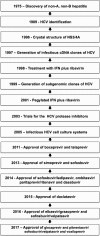Hepatocellular Carcinoma Mechanisms Associated with Chronic HCV Infection and the Impact of Direct-Acting Antiviral Treatment
- PMID: 32346535
- PMCID: PMC7167284
- DOI: 10.2147/JHC.S221187
Hepatocellular Carcinoma Mechanisms Associated with Chronic HCV Infection and the Impact of Direct-Acting Antiviral Treatment
Abstract
Hepatitis C virus (HCV) infection is the major risk factor for liver cirrhosis and hepatocellular carcinoma (HCC). The mechanisms of HCC initiation, growth, and metastasis appear to be highly complex due to the decade-long interactions between the virus, immune system, and overlapping bystander effects of host metabolic liver disease. The lack of a readily accessible animal model system for HCV is a significant obstacle to understand the mechanisms of viral carcinogenesis. Traditionally, the primary prevention strategy of HCC has been to eliminate infection by antiviral therapy. The success of virus elimination by antiviral treatment is determined by the SVR when the HCV is no longer detectable in serum. Interferon-alpha (IFN-α) and its analogs, pegylated IFN-α (PEG-IFN-α) alone with ribavirin (RBV), have been the primary antiviral treatment of HCV for many years with a low cure rate. The cloning and sequencing of HCV have allowed the development of cell culture models, which accelerated antiviral drug discovery. It resulted in the selection of highly effective direct-acting antiviral (DAA)-based combination therapy that now offers incredible success in curing HCV infection in more than 95% of all patients, including those with cirrhosis. However, several emerging recent publications claim that patients who have liver cirrhosis at the time of DAAs treatment face the risk of HCC occurrence and recurrence after viral cure. This remains a substantial challenge while addressing the long-term benefit of antiviral medicine. The host-related mechanisms that drive the risk of HCC in the absence of the virus are unknown. This review describes the multifaceted mechanisms that create a tumorigenic environment during chronic HCV infection. In addition to the potential oncogenic programming that drives HCC after viral clearance by DAAs, the current status of a biomarker development for early prediction of cirrhosis regression and HCC detection post viral treatment is discussed. Since DAAs treatment does not provide full protection against reinfection or viral transmission to other individuals, the recent studies for a vaccine development are also reviewed.
Keywords: DAA; ER stress; HCC; HCV; IFN; autophagy; direct-acting antiviral; endoplasmic reticulum stress; hepatitis C virus; hepatocellular carcinoma; interferon.
© 2020 Dash et al.
Conflict of interest statement
The authors report no conflicts of interest in this work.
Figures






References
Publication types
Grants and funding
LinkOut - more resources
Full Text Sources

